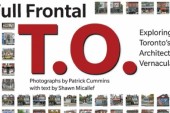
 Canadian native, Margaret Atwood, grew up for the most part in Toronto, living in the city for the vast majority of her adult life. It should come as very little surprise then that Atwood’s novels are at times heavily influenced by her city of residence. What’s less noticeable, but arguably equally as important, is the influence Atwood has on Toronto in not only her life as intellectual celebrity (not to be confused with capital-C Celebrity), but in her fiction as well. Take, for example, the opening pages of Atwood’s year-2000 novel The Blind Assassin where a woman commits suicide shortly after World War II by driving off a bridge, falling a hundred feet down into a ravine, flaming car rolling into the shallow creek at the bottom. The reader finds out later in a fictional article from The Toronto Star that “a coroner’s inquest has returned a verdict of accidental death in last week’s St. Clair Ave. fatality” (The Blind Assassin, 29). The only bridge on St. Clair Ave. in Toronto with a ravine and creek underneath it is located just east of Yonge St. over David Balfour Park. With this knowledge, it’s prudent to conclude that said bridge is the Vale of Avoca bridge, named after the ravine it spans. One of the most dramatic and central scenes to The Blind Assassin takes place in this identifiable Toronto location at the very beginning of the novel. By virtue of the very space itself (which Atwood most likely encountered in her youth, having lived in the area and attended nearby Leaside High School) being used as a setting, Toronto is established as a space affecting the writing of Atwood. More interestingly, however, is the influence of our author on the city of Toronto. In generalities, it is often said that Toronto as a city, and as synecdoche, Canada as a country, is one of little history. But I, as many would agree, align with the view that this city is instead of a lost or forgotten history. Evidence of this can be seen in the evolution of Toronto’s architectural spaces where older buildings are constantly demolished to make room for contemporary replacements. Toronto does not openly value its own history, both metaphorically and literally bulldozing it over. This brings us back to the Vale of Avoca bridge mentioned in The Blind Assassin. Admittedly, I had to look up the bridge’s name and history once I discovered the novel pointed to it, even though it was built very close to the neighbourhood I grew up in and still frequent (and subsequent online sleuthing bared little fruit– further proof of Torontonian historical amnesia). While the very nature of Atwood mentioning the space points readers in the direction of the bridge’s history, it doesn’t explicitly outline it. In fact, historical detail seems to be absent from much of The Blind Assassin— strange for a novel of historical fiction. But this is once again the city of Toronto’s influence on our author’s writing. A city that buries its history spawns historical fictions with little historical detail. This is where Atwood’s writing influences the city in a very interesting way. Because this Toronto space is detached from its history, Atwood is able to invent a history for it. Here, Atwood imposes the story of a fictional car wreck as part of a fictional history of the bridge. The writing of this historical fiction can also help to reveal the bridge’s true past. I, for one, took the time to identify the Vale of Avoca bridge, read a little into its past to investigate if any cars had driven off it after the Second World War. In this way, Atwood not only affects the Toronto city space by inscribing fictional history onto it, but through storytelling, Atwood reminds readers that Toronto’s a city with hidden historical value, potentially pushing readers into uncovering parts of the city’s forgotten past. Atwood’s affect on Toronto, and the city’s affect on her, is not limited to exposing itself through the author’s prose. Atwood, as a public speaker and figure, frequently takes up causes that effect the Torontonian and global community. Atwood is an environmental activist, having written the foreword to David Suzuki’s book The Legacy as well a post-apocalyptic science fiction novel called The Year of the Flood, overlaid with heavy environmental overtones. (She also tweets about it non-stop). Probably the most publicly famous cause that Atwood most recently took up, however, is her political battle with Toronto mayor Rob Ford, whose proposed budget cuts to the Toronto Public Library were seen as potentially devastating by Atwood. The involvement of Atwood in Torontonian politics is telling of not only how the city’s politics affect her, but also of how she attempts to affect the city’s politics. Atwood is affected by, and in turn affects, the political sphere in Toronto on top of the city’s history. Through the art of Canadian storytelling, Atwood is simultaneously able to write over the city’s history, and in turn reveal it. In this way, Atwood’s writing helps invent the history of a city without one, while engaging reader curiosity to uncover lost Canadian pasts. It is also clear that the environmental and social politics of the city, and Atwood’s engagement within this sphere, affect her writing as much as she affects them. Undoubtedly, Atwood’s relationship with Toronto’s history, politics, and spaces is a two-way street, both affecting one another in visible ways. The city of Toronto seems to be as much a part of Margaret Atwood as Margaret Atwood is of the city. Photography by Gabriel-Li
Canadian native, Margaret Atwood, grew up for the most part in Toronto, living in the city for the vast majority of her adult life. It should come as very little surprise then that Atwood’s novels are at times heavily influenced by her city of residence. What’s less noticeable, but arguably equally as important, is the influence Atwood has on Toronto in not only her life as intellectual celebrity (not to be confused with capital-C Celebrity), but in her fiction as well. Take, for example, the opening pages of Atwood’s year-2000 novel The Blind Assassin where a woman commits suicide shortly after World War II by driving off a bridge, falling a hundred feet down into a ravine, flaming car rolling into the shallow creek at the bottom. The reader finds out later in a fictional article from The Toronto Star that “a coroner’s inquest has returned a verdict of accidental death in last week’s St. Clair Ave. fatality” (The Blind Assassin, 29). The only bridge on St. Clair Ave. in Toronto with a ravine and creek underneath it is located just east of Yonge St. over David Balfour Park. With this knowledge, it’s prudent to conclude that said bridge is the Vale of Avoca bridge, named after the ravine it spans. One of the most dramatic and central scenes to The Blind Assassin takes place in this identifiable Toronto location at the very beginning of the novel. By virtue of the very space itself (which Atwood most likely encountered in her youth, having lived in the area and attended nearby Leaside High School) being used as a setting, Toronto is established as a space affecting the writing of Atwood. More interestingly, however, is the influence of our author on the city of Toronto. In generalities, it is often said that Toronto as a city, and as synecdoche, Canada as a country, is one of little history. But I, as many would agree, align with the view that this city is instead of a lost or forgotten history. Evidence of this can be seen in the evolution of Toronto’s architectural spaces where older buildings are constantly demolished to make room for contemporary replacements. Toronto does not openly value its own history, both metaphorically and literally bulldozing it over. This brings us back to the Vale of Avoca bridge mentioned in The Blind Assassin. Admittedly, I had to look up the bridge’s name and history once I discovered the novel pointed to it, even though it was built very close to the neighbourhood I grew up in and still frequent (and subsequent online sleuthing bared little fruit– further proof of Torontonian historical amnesia). While the very nature of Atwood mentioning the space points readers in the direction of the bridge’s history, it doesn’t explicitly outline it. In fact, historical detail seems to be absent from much of The Blind Assassin— strange for a novel of historical fiction. But this is once again the city of Toronto’s influence on our author’s writing. A city that buries its history spawns historical fictions with little historical detail. This is where Atwood’s writing influences the city in a very interesting way. Because this Toronto space is detached from its history, Atwood is able to invent a history for it. Here, Atwood imposes the story of a fictional car wreck as part of a fictional history of the bridge. The writing of this historical fiction can also help to reveal the bridge’s true past. I, for one, took the time to identify the Vale of Avoca bridge, read a little into its past to investigate if any cars had driven off it after the Second World War. In this way, Atwood not only affects the Toronto city space by inscribing fictional history onto it, but through storytelling, Atwood reminds readers that Toronto’s a city with hidden historical value, potentially pushing readers into uncovering parts of the city’s forgotten past. Atwood’s affect on Toronto, and the city’s affect on her, is not limited to exposing itself through the author’s prose. Atwood, as a public speaker and figure, frequently takes up causes that effect the Torontonian and global community. Atwood is an environmental activist, having written the foreword to David Suzuki’s book The Legacy as well a post-apocalyptic science fiction novel called The Year of the Flood, overlaid with heavy environmental overtones. (She also tweets about it non-stop). Probably the most publicly famous cause that Atwood most recently took up, however, is her political battle with Toronto mayor Rob Ford, whose proposed budget cuts to the Toronto Public Library were seen as potentially devastating by Atwood. The involvement of Atwood in Torontonian politics is telling of not only how the city’s politics affect her, but also of how she attempts to affect the city’s politics. Atwood is affected by, and in turn affects, the political sphere in Toronto on top of the city’s history. Through the art of Canadian storytelling, Atwood is simultaneously able to write over the city’s history, and in turn reveal it. In this way, Atwood’s writing helps invent the history of a city without one, while engaging reader curiosity to uncover lost Canadian pasts. It is also clear that the environmental and social politics of the city, and Atwood’s engagement within this sphere, affect her writing as much as she affects them. Undoubtedly, Atwood’s relationship with Toronto’s history, politics, and spaces is a two-way street, both affecting one another in visible ways. The city of Toronto seems to be as much a part of Margaret Atwood as Margaret Atwood is of the city. Photography by Gabriel-Li













